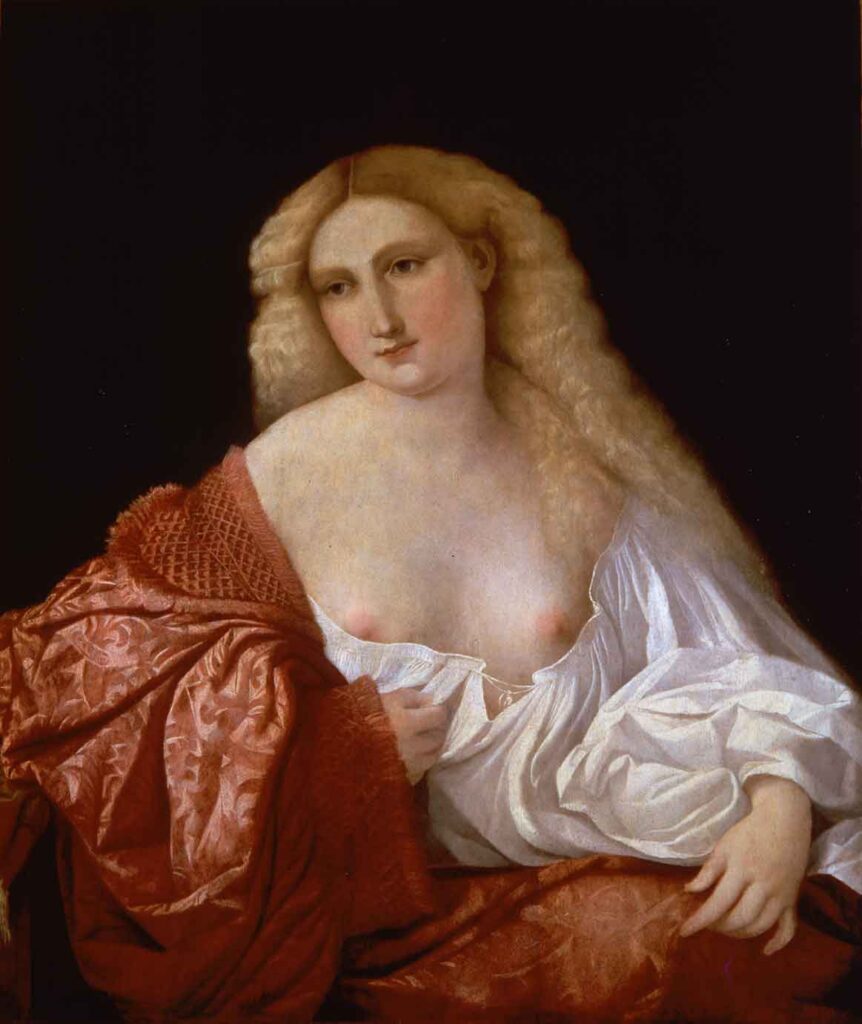Portrait of a Woman known as The Courtesan
Jacopo Palma il Vecchio , ca. 1520
Description

The woman wears over her white blouse a beautiful and rich surcoat, probably of silk damask, dyed red, the color at the time among the most precious and sought-after.Like other female portraits of Venetian production, characterized by strong eroticism, this one has traditionally been considered a portrait of a courtesan. In fact, the typology of early 16th-century Venetian female portraits to which this painting belongs has precise references to the theme of marriage.The women depicted often expose a breast, a doorway to the soul and heart, a symbol of fecundity, an offering of love, a seductive lure.
The fact that one breast is shown and the other partly covered does not signify an antithesis between voluptuousness and virtue, but a co-presence of enunciated and lived eroticism, and moderate and guarded eroticism that is realized in marriage. The woman depicted here has long, loose hair, a long-standing tradition for brides in the Veneto; she has loosened her mantle, which is slipping off her body, and is wearing a white blouse, an emblematic element of the wedding trousseau and also a symbol of chastity. The association between red and white, the colors of love, also corresponds to this interpretive key.
The power of female sexuality is expressed not only through the display of the body, but also and especially through the established mechanisms of gestures and gaze.Jacopo Palma il Vecchio, a native of the Bergamo area but Venetian by adoption, was famous for producing these half-length images of flourishing and prococious female beauties, reinterpreting an invention that had been Titian’s. The painting, datable to about 1520, is in the artist’s late production. The painting technique, which gives the color surface a fragile, parched appearance, is echoed in other works from the painter’s later activity and confirms this dating.
Data Sheet
Author
Jacopo Palma the Elder, 1480 ca.-1528
Date
ca. 1520
Material and technique
Oil on canvas
Measures
87.4 cm x 73.5 cm
Acquisition
Gian Giacomo Poldi Pezzoli bequest, 1879
Inventory number
0372
location
Palma Room
The historic Palma Room constitutes the main entrance to the Trivulzio Room, which Gian Giacomo Poldi Pezzoli had chosen as the prime location for his collection of antique weapons, now displayed in the new Armory on the ground floor. The room houses a painting by Palma the Elder and the valuable collection of sundials by architect Piero Portaluppi: more than two hundred pieces that came to the Museum in 1978, five years after the substantial donation of mechanical clocks from the Falck collection on display in the Hall of Clocks.
collection
Paintings
The Museum hosts over 300 paintings. Among them, many Italian works from the Renaissance: masterpieces from Tuscany (Botticelli, Piero della Francesca, Pollaiuolo), Lombardy (Luini, Boltraffio, Solario) and Veneto (Bellini, Mantegna). Important is also the group of 18th century Italian painting (Guardi, Canaletto, Tiepolo, Fra Galgario). In the collection, there are mainly portraits and small size paintings.
